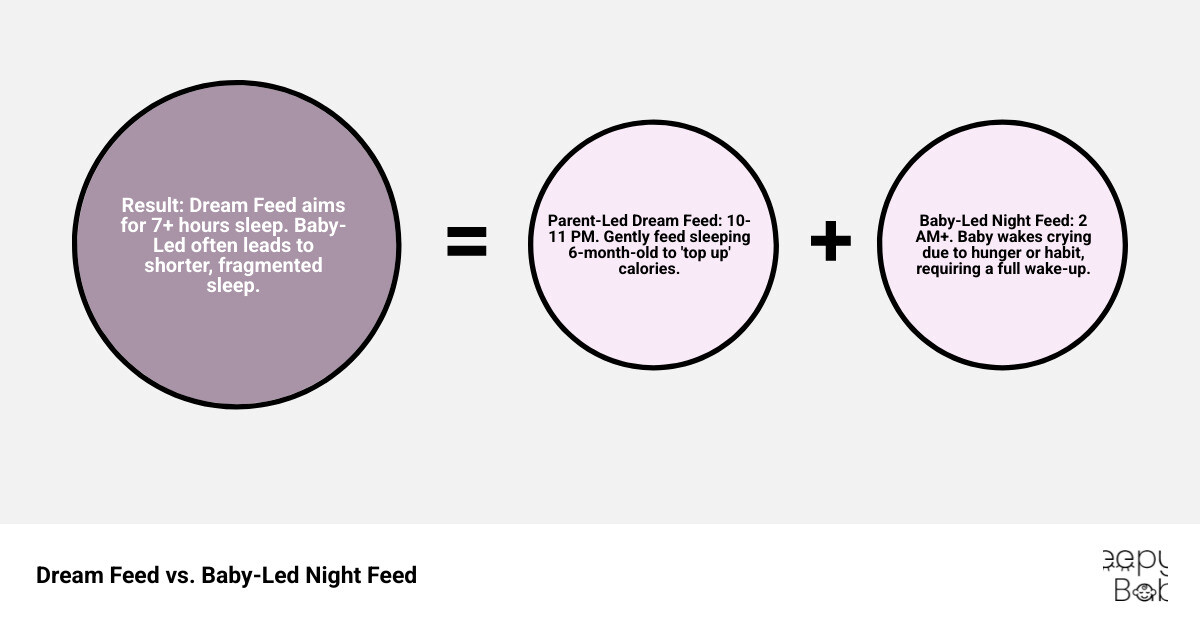Why the 6 Month Old Dream Feed Deserves Your Attention
A 6 month old dream feed is a late-evening feeding you give your baby while they're mostly asleep, typically between 10 PM and midnight, to help them sleep longer overnight. Here's a quick overview:
- What it is: A parent-initiated feeding given to a sleeping baby 2-3 hours after bedtime.
- Goal: To "top up" your baby's calories before you go to bed, extending their longest sleep stretch.
- Best timing: Between 10 PM and 11 PM.
- Expected result: Your baby may sleep 7+ hours after the feed.
- When to stop: Around 6-8 months, especially once solids are established.
- Red flags: More night wakings, difficulty settling, or waking to expect the feed.
Fragmented sleep is a hallmark of new parenthood. The dream feed promises a solution: aligning your baby's longest sleep stretch with your own. But at 6 months, things get complicated. Your baby is eating solids, their sleep patterns are maturing, and the dream feed that once worked wonders might now be causing more wake-ups.
The core question is whether a dream feed still works for your 6-month-old. At this transitional age, some babies need the calories, while for others, it's become a disruptive habit. As a father and founder of Sleepy Baby, I've learned that sleep solutions aren't one-size-fits-all. This guide will help you decide if a dream feed is right for your family, how to do it effectively, and when it's time to stop.

6 month old dream feed further reading:
What is a Dream Feed and Is It Right for Your 6-Month-Old?
A dream feed is a late-night feeding that you initiate while your baby is mostly asleep, typically between 10 PM and midnight. The goal is simple: top up your baby's calories before you go to bed, pushing their next hunger wake-up later into the night so you both get a longer stretch of sleep.
By six months, however, your baby is changing. They're starting solids, their sleep cycles are maturing, and they can naturally sleep for longer. The dream feed that was a lifesaver at 3 months might now be unnecessary or even disruptive. The question is whether it still works for your specific baby at this age.
Here's a quick comparison to help you weigh the decision:
| Pros of Dream Feeding a 6-Month-Old | Cons of Dream Feeding a 6-Month-Old |
|---|---|
| Extends parent's sleep window | May disrupt baby's deep sleep cycles |
| Consolidates night feedings into one | Can create a "habit wake" at that time |
| Ensures adequate calorie intake for active babies | Potential for overfeeding, gas, and reflux |
| Reduces early morning hunger wakings | May lead to less interest in morning feed |
| Can be a bridge during growth spurts | Risk of ear infections (if bottle-feeding lying flat) |
| Allows for more predictable sleep patterns | Might hinder self-settling skills development |
The Potential Benefits
When a dream feed works, the primary benefit is longer sleep for parents. By shifting a potential 2 AM wake-up to 5 AM or later, you can get a solid, uninterrupted block of sleep. For active 6-month-olds who are easily distracted during daytime feeds, it also ensures adequate calorie intake in a calm setting. Research supports the concept of calorie consolidation, with one study finding that babies given a focused bedtime feed slept longer. Help me make it through the night: behavioral entrainment of breast-fed infants’ sleep patterns. For babies who are genuinely hungry at night, a dream feed can consolidate multiple wakings into one predictable feed.
The Potential Downsides and Risks
At 6 months, the risks of dream feeding become more prominent. A major concern is disrupting deep sleep cycles. Your baby's sleep is maturing, and rousing them, even gently, can interrupt the restorative deep sleep that occurs early in the night. This can ironically lead to more wake-ups later.
Another significant risk is creating a habitual waking. If your baby no longer needs the calories, offering a feed at the same time every night can condition them to wake up for it out of habit, not hunger. This is a common reason behind frustrating, recurring wake-ups. You can learn more about this pattern in Why Your 6-Month-Old Keeps Waking Up and How to Fix It.
Finally, there are physical discomforts like overfeeding, gas, and reflux. Feeding a baby who isn't hungry can cause tummy pain. For bottle-fed babies, feeding while they lie too flat also increases the risk of ear infections. Always hold your baby in a semi-upright position for any feed.
The Ultimate Guide to a 6 Month Old Dream Feed
If you've decided a 6 month old dream feed is right for your family, mastering the technique is key. Done correctly, it's a powerful tool; done poorly, it can disrupt sleep even more.

The ideal timing is between 10 PM and 11:30 PM, about 2-3 hours after your baby's bedtime. This allows you to feed them and then head to bed for your own long stretch of sleep. The environment should be dark, quiet, and boring to keep your baby in a drowsy state.
How to Perform a Dream Feed Effectively
Getting the mechanics right is crucial for success.
- Prepare the space: Dim the lights and have the bottle or your nursing station ready to minimize fumbling.
- Rouse gently: Pick your baby up smoothly from the crib. You want them just awake enough to feed. A gentle stroke on the cheek can encourage them to latch.
- Position correctly: Always hold your baby in a semi-upright position to prevent choking and reduce the risk of ear infections.
- Offer a full feed: Encourage your baby to take a complete feeding (e.g., 5-10 minutes per side for breastfeeding or a full 4-6 ounce bottle) to ensure they are full for the night.
- Burp if needed: Many 6-month-olds don't need much burping during a dream feed. However, if your baby is gassy, hold them upright for 10-15 minutes to release any trapped air.
- Return to crib: Place your baby back in their crib on their back without any extra stimulation. The goal is for them to barely register the interruption. This routine fits well within The 6-Month-Old Sleep and Feeding Schedule Your Baby Will Love.
Special Considerations for Your 6-Month-Old
At six months, several factors can influence the dream feed:
- Solid Foods: While your baby is starting solids, breast milk or formula is still their primary nutrition. Ensure they are getting enough calories during the day so the dream feed doesn't cause them to eat less when awake.
- Growth Spurts: A temporary increase in hunger around 6 months might make a dream feed helpful for a short period.
- 6-Month Sleep Regression: This developmental phase can cause sudden night wakings. Since it's not usually hunger-driven, a dream feed may not be the solution and could even add to the disruption. Learn the signs in 6-Month Sleep Regression: Signs Every Parent Should Know.
Using Sleep Aids to Support the 6 month old dream feed
Getting your baby back to sleep quickly and independently after the feed is the final step.

This is where a sleep aid can help. At Sleepy Baby, our devices are designed for this challenge. They feature rhythmic patting that mimics a caregiver's soothing touch, helping your baby drift back to sleep without you needing to stay and pat their back. You simply place the device on your baby's chest and let it provide consistent, hands-free comfort.
Our aids also include safe white noise. While some older machines have raised concerns about volume, modern, safety-rated devices like ours use carefully controlled, low-decibel sound. This gentle noise masks household sounds that might otherwise wake your baby.
The combination of rhythmic patting and safe white noise helps your baby resettle after a 6 month old dream feed and fosters independent sleep skills, leading to better rest for the whole family.
Troubleshooting: When a Dream Feed Isn't a Dream
Sometimes, a dream feed creates more problems than it solves. If your baby's sleep seems worse after continuing a 6 month old dream feed, it might be time to reassess. What worked at 3 months may be sabotaging sleep at 6 months.

Look for these clear signs that the dream feed is no longer helpful:
- Increased night wakings: Instead of sleeping longer, your baby wakes more often, especially shortly after the dream feed. This suggests their sleep cycle is being disrupted.
- Difficulty settling after the feed: If it takes more than a few minutes to get your baby back to sleep, the feed is likely overstimulating them and defeating its purpose.
- Baby refuses the feed or takes very little: If your baby turns away from the breast or bottle or only takes a small amount, they are telling you they aren't hungry.
- Worsening reflux or gas: Increased fussiness, spitting up, or gassiness after the feed indicates their digestive system may not need the extra milk at night.
- Waking to expect the feed: The most telltale sign is your baby starting to wake up on their own between 10 and 11 PM. This is a "habit wake," meaning the dream feed has become a sleep association that is now causing the problem.
At 6 months, the issue is often not hunger but a sleep association or developmental change. If you're facing these challenges, you can find more strategies in Nighttime Battles: Why Your 6-Month-Old Won't Sleep. If the dream feed is causing more trouble than it's worth, it's okay to let it go.
The End of an Era: When and How to Stop Dream Feeding
Most babies are ready to drop the dream feed between 6-8 months. At this age, they are developmentally capable of sleeping longer stretches without calories. Their stomachs are bigger, their sleep is more mature, and the introduction of solids means they're getting more nutrition during the day. The 6 month old dream feed that was once essential may now be a hindrance.
It's likely time to stop if your baby is showing the troubleshooting signs mentioned earlier, or if they are already sleeping for 7+ hours after the feed. This shows they can sustain themselves overnight. When you're ready to stop, you can choose between two methods: cold turkey or a gradual reduction. For more on this transition, see Midnight Snacks No More: Your Guide to 6-Month-Old Night Feeding.
How to Wean from the 6 month old dream feed
Weaning from a dream feed is often easier than other feeds because your baby is mostly asleep. A gradual approach is usually smoothest.
- For bottle-fed babies: Reduce the volume by 1 ounce every 1-2 nights. If they take 6 ounces, offer 5, then 4, and so on, until the feed is eliminated. This allows their body to adjust its hunger cues to the daytime.
- For breastfed babies: Reduce the nursing time by 1-2 minutes every few nights. If you usually nurse for 10 minutes, cut back to 8, then 6, until the feed is very short and can be dropped.
- Push the feed time earlier: Another option is to move the feed 15 minutes earlier every few nights. As it gets closer to their bedtime feed, it becomes redundant and can be easily dropped.
During this process, the most critical step is to ensure sufficient daytime calories. Your baby must get enough milk and solids during waking hours to avoid genuine nighttime hunger. Offer feeds more frequently during the day if needed. For guidance on formula amounts, resources like Amount and Schedule of Formula Feedings can be helpful. Be patient and consistent, and trust that you are helping your baby develop healthy, independent sleep skills.
Frequently Asked Questions about Dream Feeding
Here are answers to common questions parents have about the 6 month old dream feed.
Do I need to burp my baby after a dream feed?
Probably not. Babies are relaxed during a dream feed and swallow less air. However, if your baby is prone to reflux or gas, it's a good idea to hold them upright for 10-15 minutes after the feed. A few gentle pats on the back can help release any trapped air. If your baby seems uncomfortable without a burp, make it part of the routine. Otherwise, you can likely skip it.
Can a dream feed cause my baby to wake up more?
Yes, it absolutely can. At 6 months, a dream feed can backfire for two main reasons:
- Habitual Waking: If your baby no longer needs the calories, their body can become conditioned to wake up expecting the feed, turning it into a disruptive habit.
- Sleep Cycle Disruption: Rousing your baby, even gently, can pull them out of deep, restorative sleep. If they struggle to get back into a deep sleep state, they may wake more frequently later in the night.
If the dream feed is causing more wake-ups, it's a sign that the issue is likely hunger vs. habit, and it's time to consider weaning from the feed.
How many ounces should a 6-month-old have for a dream feed?
The goal is to offer a full feeding to sustain your baby for a long stretch.
- Formula feeding: Offer the same amount as a typical daytime feed, usually 6-8 ounces. Let your baby decide how much to take; don't force them to finish.
- Breastfeeding: Nurse for your baby's typical feeding duration, ensuring they get a complete feed rather than just a snack.
Remember to account for daytime calories from both milk and solids. If your baby consistently takes very little during the dream feed, they are likely telling you they don't need it and may be ready to drop it.
Conclusion
The 6 month old dream feed is a sleep tool that can be a savior for some families and a hindrance for others. As your baby grows, what once worked may no longer be effective. The key is to remember that dream feeding is not a necessity for all babies, and many sleep through the night without it.
Trust your parental instinct and pay attention to your baby's cues. Is the dream feed helping, or is it creating a disruptive habit? As your baby starts solids and their sleep matures, your strategies should adapt. The goal is sustainable, healthy sleep for everyone.
At Sleepy Baby, we're dedicated to helping your baby learn to self-settle and achieve restorative sleep. By focusing on a holistic approach that includes consistent routines and supportive tools like our rhythmic patting and safe white noise devices, you can build a foundation for peaceful nights.
Navigating infant sleep is challenging, but you're not alone. For more guidance, we invite you to Explore more expert sleep tips on our blog. Here's to more rest for you and your baby.



